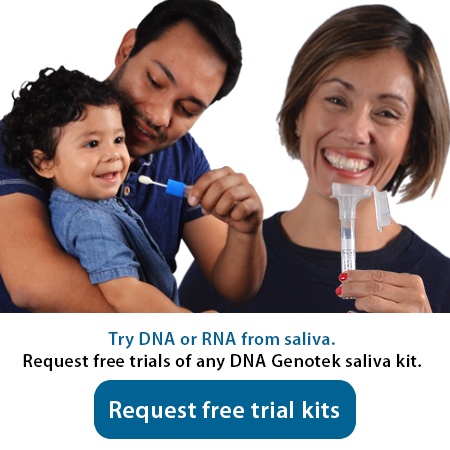2015-05-12
Methylated cytosine, also known as “the fifth base of DNA” has attracted a lot of research attention lately due to its importance in controlling gene expression. This fifth base has inspired researchers to study its impact on several diverse fields, such as oncology, neurology, psychology, forensics and even workplace health and safety. Methylated cytosine has even been used as a predictor of biological age [1].In this blog post I’d like to share a few examples of the exciting ways this “extra” base is providing new avenues for research.
DNA methylation of cytosine residues is thought to control the expression of our genes in two ways. Methylation of the promoter region of genes may impede the binding of transcription factor proteins so that the machinery required to translate the gene into a protein is blocked from serving its function [2]. DNA methylation can also cause proteins to be recruited to certain sites on the DNA, causing the DNA to wind up so tightly it effectively prohibits transcription factor proteins from accessing the gene [2]. By turning off key genes in specific cell types, the process of DNA methylation helps control cell differentiation and influences cellular function. The mechanistic importance of DNA methylation alone makes it an extremely interesting DNA modification to study.
For those who may not be familiar with this approach, there are basically two steps in the general technique for detecting cytosine methylation in tissues and biological fluid. First methylated and unmethylated fragments of DNA are differentiated by either physically separating them or changing their sequence. For example, bisulfite treatment makes the sequence of methylated and unmethylated fragments different by changing unmethylated cytosine into uracil [2]. The bisulfite-treated DNA is them amplified by PCR and the sequence changes evaluated using microarrays or DNA sequencing. [2].
Depending on your gene of interest, methylation patterns can vary between tissue types. This difference in methylation patterns can be very useful. For instance, in a recent publication, Dr. Seth Faith’s research group at Battelle Memorial Institute used methylation to identify the tissue source of mysterious biological samples [3]. By adapting DNA methylation detection to a next generation sequencing (NGS) platform, they compared DNA samples from 4 different tissue types: saliva (collected and stabilized with Oragene kits), blood, semen and skin. The researchers found that their new NGS assay was able to correctly identify the tissue origin for each of the sample types [3]. This is of obvious benefit to the world of forensic identification.
In other cases, DNA methylation patterns can be shared between different tissues. This can be helpful when researchers are trying to identify a disease or disorder where the affected tissue type is not readily accessible. For example, dysfunctional serotonin signalling has been linked to many psychiatric disorders. Dr Homid Abdolmaleky and his colleagues found that in post-mortem brain samples from schizophrenia patients, the serotonin transporter gene promoter region was hypermethylated. While the discovery was very interesting, a diagnostic biomarker that relies on biopsying live brain tissue would be ethically tricky, to say the least. Fortunately, they found that the epigenetic marker was not only present in post-mortem brain tissue, but also in DNA extracted from Oragene/saliva samples, a sample type that is much easier to collect from living patients [4].
A biomarker doesn’t necessarily have to be discovered in the affected tissue. While in the above study researchers looked for biomarkers in brain tissue and saliva samples, in the next study psychiatric researchers used only a non-invasive, easy to collect sample type when they looked for a depression biomarker. In a cross-sectional occupational-cohort study, Dr. Yixuan Song and colleagues at the National Center for Global Health and Medicine in Tokyo, Japan asked employees of a major Japanese manufacturing company to provide genetic samples using Oragene kits for saliva collection. The same employees were surveyed for depressive symptoms and job-stress indicators. DNA was extracted and bisulfite-converted before being hybridized onto the Infinium HumanMethylation450 BeadChip (Illumina, San Diego, CA). Researchers looked specifically at methylation patterns in the brain-derived neurotrophic factor (BDNF) gene because changes in methylation of this gene have been linked to depression. They found significant changes in DNA methylation of the BDNF gene in people who exhibited depressive symptoms or had high levels of job stress compared to those who didn’t.
According to the authors “this indicates that DNA methylation in this gene is a promising biomarker for diagnosing depression.” [5]
Finally, there is another aspect of epigenetic marks like DNA methylation that make them extremely valuable sources of information to track over a period of time. Methylation patterns can change and these changes can be in response to many different factors, including environmental exposures. In a cross sectional study Dr. Jun Kim, in collaboration with researchers from the Universities of Michigan and Nebraska and the Tanta Cancer Center in Egypt, measured genome-wide methylation in saliva DNA extracted from Oragene kits using the Infinium HumanMethylation27 BeadChip (Illumina, San Diego, CA). They identified alterations in saliva DNA methylation that were correlated with bisphenol A (BPA) concentrations in urine [6]. Exposure to BPA, an endocrine disrupter, has been linked to an increased risk in cardiovascular disease, type 2 diabetes, liver abnormalities and childhood obesity [6]. This study illustrates the possibility that a DNA methylation-based biomarker could identify individuals exposed to dangerous pollutants, such as high levels of BPA.
It seems singer Meghan Trainor is not alone in her interest in ‘that base’. From tissue identification to biomarkers of depression to measures of environmental exposure, these are just some of the exciting ways researchers are using the fifth base to understand new things about our health and well-being. I’m looking forward to reading more about epigenetics and methylated cytosine, because it really seems that, like Ms. Trainer and researchers around the world, I too am all about that base!
References
1. Bocklandt S et al. Epigenetic predictor of age. PLoS One. 6(6):e14821 (2011).
2. Levenson VV et al. DNA methylation as a universal biomarker. Expert Rev Mol Diagn. 10(4): 481-488 (2010).
3. Bartling CM et al. Next-generation sequencing approach to epigenetic-based tissue source attribution. Electrophoresis. 35(21-22): 3096-3101 (2014).
4. Abdolmaleky HM et al. DNA hypermethylation of serotonin transporter gene promoter in drug naïve patients with schizophrenia. Schizophr Res. 152(2): 373-380 (2014)
5. Song Y et al. Altered DNA methylation status of human brain derived neurotrophis factor gene could be useful as biomarker of depression. Am J Genet Part B. 165B:357-364 (2014).
6. Kim JH et al. Bisphenol A-associated epigenomic changes prepubescent girls: a cross-sectional study in Gharbiah, Egypt. Environ Health. 12:33 (2013).


